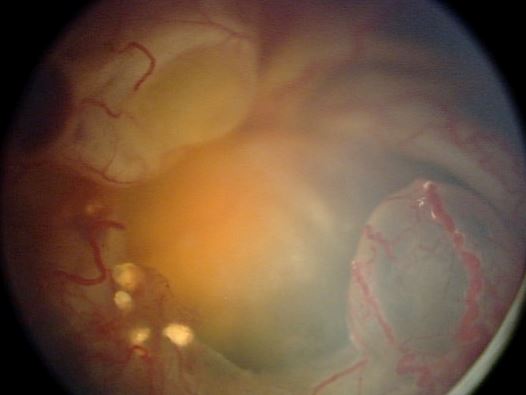Watch above: It’s a rare disease that affects blood vessels and the retina and could lead to blindness. Meaghan Craig introduces us to a young boy with Coats’ Disease whose parents seek support from others dealing with the abnormality.

SASKATOON – If you are a parent of a young child particularly a little boy, you’ll want to flip through your photos. Experts say something as simple as a camera flash can help you detect if there’s something really wrong with your child’s eye health, possibly preventing them from going blind.
It’s something one Saskatoon family said they wished they had known sooner after their child’s vision in one eye deteriorated over a matter of months because of Coats’ Disease.

This is what Coats’ Disease looks like. Seventy per cent of cases are boys diagnosed before their tenth birthday.
“The retina is is like film inside of the camera so it’s the part of the eye that takes the picture back to the brain and with Coats’ Diseases there’s a problem with the blood vessels,” said Dr. Nigel Rawlings, a retina specialist with Saskatoon Retina Consultants.
“The blood vessels in the back of the eye are very leaky and they leak protein and fluid and as a result you can have swelling in the retina and some of these kids can end up with a partial or a total retinal detachment.”
READ MORE: Bionic Lens to provide perfect vision: inventor
- Canadian man dies during Texas Ironman event. His widow wants answers as to why
- ‘Sciatica was gone’: hospital performs robot-assisted spinal surgery in Canadian first
- Canadians more likely to eat food past best-before date. What are the risks?
- Treatment from female doctors leads to lower death rates, study finds
According to Rawlings, Coats’ Disease usually only affects one eye and treatment depends on the severity which means early detection is key.
“In some kids we can treat the abnormal blood vessels by using a laser or by using a freezing treatment but then for more advance situations we sometimes have to do surgery and sometimes we have to inject a medicine into the eye to make the blood vessels leak less.”
There are three warning signs Rawlings recommends parent look for; a decrease in your child’s vision and strabismus, simply put “when the eye turns inward or outward.”
The third is knowing the glow or looking for cat-like eyes when using flash photography.
“In most people when we use flash and you look at the eyes, there’s what you call a red reflex so human eyes normal show a nice red reflex with Coats’ Disease instead of seeing a normal red reflex you can see what we call a yellow or a white reflex.”
Rawlings warns that childhood eye cancer also presents with an abnormal red reflex.
While a picture tells a thousand words, one family says they didn’t know to look for the glow.
“If we had know about the white-eye sooner perhaps we would have been more aware to take him to a medical professional sooner,” said Eric Karmark, father of three little boys.
Last summer, Eric and his wife Anita say they noticed their second oldest son Jonathan’s right eye was wandering a bit but thought it was nothing an eye-patch couldn’t correct.
” In Jonathan’s case he went from having vision in the eye, albeit was greatly reduced to complete loss of vision over a matter of months,” added Karmark.
“The sooner you can treat your child, the sooner you can hopefully have a more positive outcome.”
Too young to articulate that there was something wrong with his eye, little Jonathan was diagnosed with Coats’ Disease in December 2013 at the age of two.
It’s a condition so rare experts say on average they see only one case in Saskatchewan every year.
“In terms of vision he’ll probably never receive vision in that eye again,” said Anita Karmark.
At this point, Jonathan has undergone laser therapy, freezing treatments and injections in order to save his eye as the family holds out hope experts will one day find a cure.
“He’s a normal, healthy, functioning child and even with one eye he can still do everything that a normal three-year-old can do, the only thing he may not have is depth-perception,” said Anita Karmark.



Comments